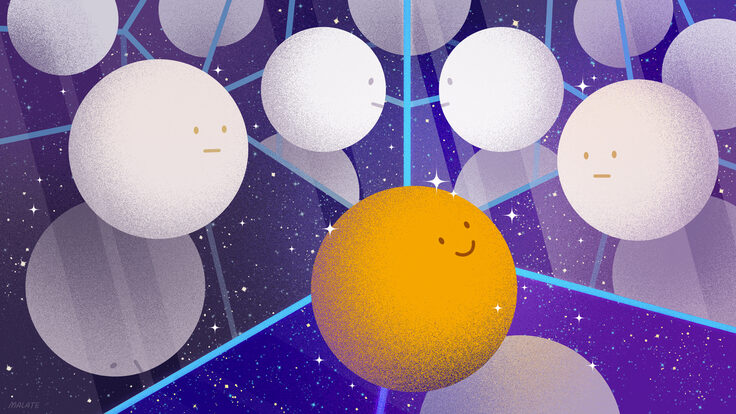The universe is vast, almost beyond comprehension. It has an estimated diameter of 93 billion light-years. And of the fundamental forces of nature, just one is capable of acting across that entire 93-billion-light-year span: gravity.
Gravity is an attractive force, which means that it pulls matter together. So it would make sense to assume that, over time, gravity should begin to pull the universe together as well. The universe expanded after the Big Bang, and gravity is here to counterbalance that effect.
But that’s not what we see. In fact, since the late 1990s, evidence has been accumulating that the universe is actually expanding at an accelerating rate.
The cause of this acceleration is unknown and is currently one of the biggest open questions in fundamental physics. How can our universe keep defying gravity?
A mysterious expansion
Albert Einstein favored the idea of a static, eternal universe—one that simply existed, no shrinking or expanding required. To make sense of this stasis despite the influence of gravity, he in 1917 modified the field equations in his Theory of General Relativity to include a new, repulsive component: The infamous “cosmological constant” was born.
Einstein later called the cosmological constant the greatest blunder of his career. That’s because in 1929, Edwin Hubble announced an astonishing discovery, based on the study of light from distant galaxies. The farther a galaxy was from the Earth, he said, the more he found its light had shifted toward the red end of the color spectrum, indicating that it was actually traveling even farther away over time. The universe was not unmoving after all; the cosmological constant was out.
In the 1940s, scientists thought they might have an alternative explanation for the expansion of the universe. It had to do with virtual particles.
Quantum mechanics dictates that even the vacuum of empty space is teeming with virtual particles, which continuously pop in and out of existence. Scientists wondered whether the pressure of those virtual particles could be what seemed to be overpowering gravity. But there was a problem with that.
As astrophysicist Ben Safdi of the University of California, Berkeley explains, “We find huge disagreements between theory and data, by 120 orders of magnitude.”
In other words, if virtual particles were exerting an expanding force on the universe, that force would be 10120 times as strong as what we actually see. It seemed that something else needed to explain the comparatively tiny force driving the universe’s expansion.
Some physicists argue that the only way to make sense of it is to turn to anthropic reasoning—the argument that our universe is one of many, and that its conditions are the way they are simply because they are the correct ones to support our existence. If things weren’t this way, we wouldn’t be here to wonder about how they came to be.
Other scientists wonder if everything could be explained by an alternative understanding of gravity. But so far, no new model of modified gravity has gained traction in the scientific community.
Another idea is that an accelerating cosmological expansion could be the result of an as-yet unknown force, a “fifth force.” Several models describing this force exist, but none explain why the magnitude it would need to produce the observed acceleration would be so small.
A leading theory
In 1998, scientists studying a type of dying star called a “Type 1a supernova” announced a momentous discovery: Not only was the universe expanding, but its expansion was speeding up.
Theoretical cosmologist Michael Turner gave whatever is causing this accelerating expansion a new name: dark energy. Scientists continue to study the changing shape of the universe to better understand what this force might be and to figure out whether it is a constant or if it changes over time.
Understanding the latter could give us a peek into the future of the universe.
Dark energy is estimated to account for approximately 70% of the universe’s total measure of matter and energy. If it continues to steadily dominate the energy-matter balance, the universe’s expansion will continue to accelerate, indefinitely.
If, however, dark energy grows stronger over time, the very fabric of reality will eventually tear apart. This apocalypse is appropriately named the Big Rip. At the other end of the spectrum, if dark energy is eventually overpowered by gravity, then the cosmos will collapse in on itself—an eventuality known as the Big Crunch.
One thing is certain: Despite its repulsive nature, the cause of our universe’s escalating expansion remains an attractive subject of investigation.













